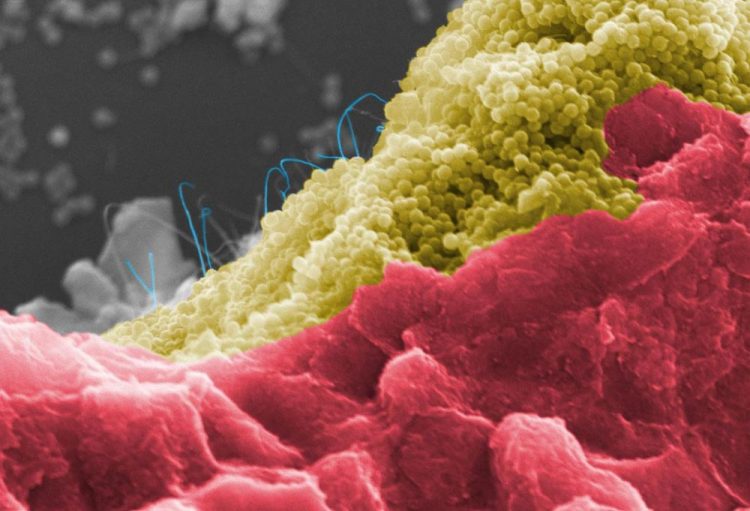Programmable nests for cells

Bacteria cells (red) on a programmable composite of silica nanoparticles (yellow) and carbon nanotubes (blue). Photo: Niemeyer-Lab, KIT
Using DNA, smallest silica particles, and carbon nanotubes, researchers of Karlsruhe Institute of Technology (KIT) developed novel programmable materials. These nanocomposites can be tailored to various applications and programmed to degrade quickly and gently.
For medical applications, they can create environments in which human stem cells can settle down and develop further. Additionally, they are suited for the setup of biohybrid systems to produce power, for instance. The results are presented in Nature Communications and on the bioRxiv platform.
Stem cells are cultivated for fundamental research and development of effective therapies against severe diseases, i.e. to replace damaged tissue, for instance. However, stem cells will only form healthy tissue in an adequate environment.
For the formation of three-dimensional tissue structures, materials are needed, which support cell functions by perfect elasticity. New programmable materials suited for use as substrates in biomedical applications have now been developed by the group of Professor Christof M. Niemeyer of the Institute for Biological Interfaces 1 – Biomolecular Micro- and Nanostructures (IBG 1) of KIT, together with colleagues from the Institute of Mechanical Process Engineering and Mechanics, the Zoological Institute, and the Institute of Functional Interfaces of KIT.
These materials can be used among others to create environments, in which human stem cells can settle down and further develop.
As reported by the researchers in Nature Communications, the new materials consist of DNA, smallest silica particles, and carbon nanotubes.
“These composites are produced by a biochemical reaction and their properties can be adjusted by varying the amounts of the individual constituents,” Christof M. Niemeyer explains. In addition, the nanocomposites can be programmed for rapid and gentle degradation and release of the cells grown inside, which can then be used for further experiments.
New Materials for Biohybrid Systems
According to another publication by the IBG 1 team on the bioRxiv bioscience platform, the new nanocomposites can also be used for construction of programmable biohybrid systems. “Use of living microorganisms integrated within electrochemical devices is an expanding field of research,” says Professor Johannes Gescher from the Institute for Applied Biosciences (IAB) of KIT, who was involved in this study.
“It is possible to produce microbial fuel cells, microbial biosensors, or microbial bioreactors in this way.” The biohybrid system constructed by KIT researchers contains the bacterium Shewanella oneidensis. It is exoelectrogenic, which means that when organic substance is degraded under the lack of oxygen, an electric current is produced.
When Shewanella oneidensis is cultivated in the nanocomposites developed by KIT, it populates the matrix of the composite, whereas the non-exoelectrogenic Escherichia coli bacterium remains on its surface. The Shewanella-containing composite remains stable for several days. Future work will be aimed at opening up new bioengineering applications of the new materials.
###
Original publications:
Yong Hu, Carmen M. Domínguez, Jens Bauer, Simone Weigel, Alessa Schipperges, Claude Oelschlaeger, Norbert Willenbacher, Stephan Keppler, Martin Bastmeyer, Stefan Heißler, Christof Wöll, Tim Scharnweber, Kersten S. Rabe, & Christof M. Niemeyer: Carbon-nanotube reinforcement of DNA-silica nanocomposites yields programmable and cell-instructive biocoatings. Nature Communications, 2019. DOI: 10.1038/s41467-019-13381-1 (Open Access)
https:/
Yong Hu, David Rehnlund, Edina Klein, Johannes Gescher, & Christof M. Niemeyer: Cultivation of Exoelectrogenic Bacteria in Conductive DNA Nanocomposite Hydrogels Yields a Programmable Biohybrid Materials System. bioRxiv, 2019. DOI: 10.1101/864967 (Open Access)
https:/
Being “The Research University in the Helmholtz Association”, KIT creates and imparts knowledge for the society and the environment. It is the objective to make significant contributions to the global challenges in the fields of energy, mobility, and information. For this, about 9,300 employees cooperate in a broad range of disciplines in natural sciences, engineering sciences, economics, and the humanities and social sciences. KIT prepares its 24,400 students for responsible tasks in society, industry, and science by offering research-based study programs. Innovation efforts at KIT build a bridge between important scientific findings and their application for the benefit of society, economic prosperity, and the preservation of our natural basis of life. KIT is one of the German universities of excellence.
Media Contact
All latest news from the category: Life Sciences and Chemistry
Articles and reports from the Life Sciences and chemistry area deal with applied and basic research into modern biology, chemistry and human medicine.
Valuable information can be found on a range of life sciences fields including bacteriology, biochemistry, bionics, bioinformatics, biophysics, biotechnology, genetics, geobotany, human biology, marine biology, microbiology, molecular biology, cellular biology, zoology, bioinorganic chemistry, microchemistry and environmental chemistry.
Newest articles

First-of-its-kind study uses remote sensing to monitor plastic debris in rivers and lakes
Remote sensing creates a cost-effective solution to monitoring plastic pollution. A first-of-its-kind study from researchers at the University of Minnesota Twin Cities shows how remote sensing can help monitor and…

Laser-based artificial neuron mimics nerve cell functions at lightning speed
With a processing speed a billion times faster than nature, chip-based laser neuron could help advance AI tasks such as pattern recognition and sequence prediction. Researchers have developed a laser-based…

Optimising the processing of plastic waste
Just one look in the yellow bin reveals a colourful jumble of different types of plastic. However, the purer and more uniform plastic waste is, the easier it is to…



